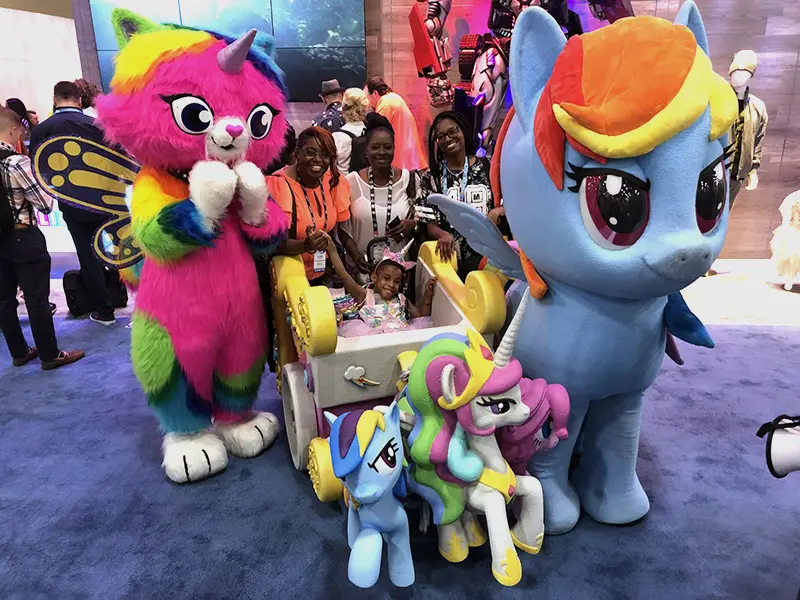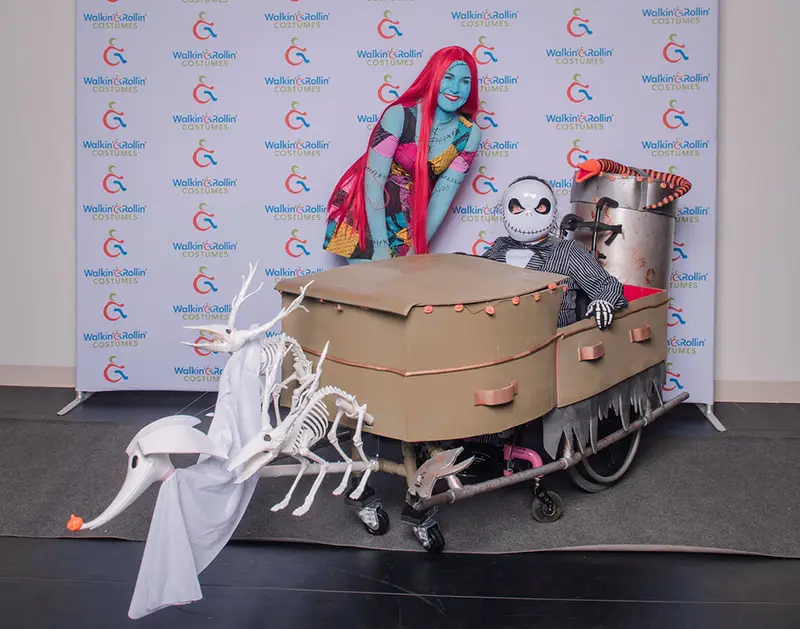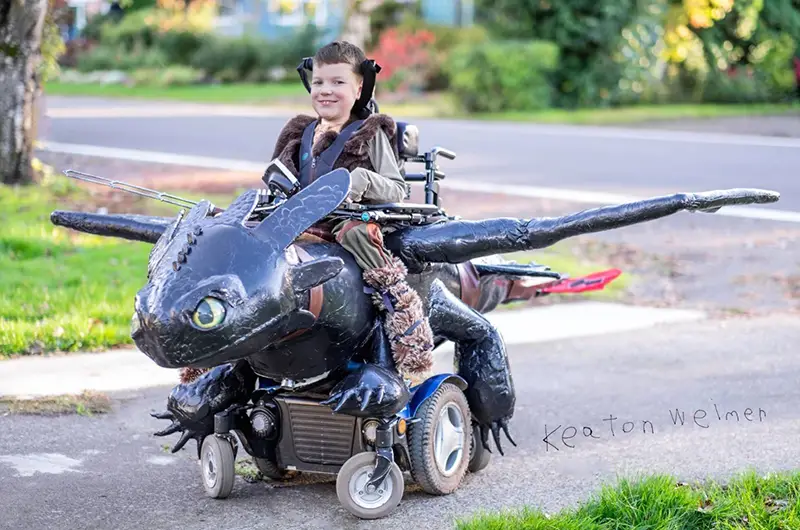Halloween is a fun-filled day for many, with kids dressing up as their favorite characters and being with their friends to show off their style. While we often think of this holiday as just for children, the child in all of us comes out during this holiday. Everyone loves dressing up as their favorite animal, princess, or hero. Over the past several years, adapted costuming has really become easier than ever!
As an occupational therapist, we often dressed up along with our patients for Halloween. They would tell us what they wanted to be, and we would help to come up with fun costume ideas to make with them. I encourage you, as a clinician, to also get involved by providing ideas and encouragement to make the families' Halloween memorable. This blog will help you get your creativity flowing so that those you work with can be who they have always dreamed of being. When either selecting or making an adapted costume, there are a few important tips to keep in mind.
While fashion is always the goal, it is important to remember function and independence as well. For example, if the child needs to propel their own chair, you may want to make sure that the wheels are free and open to allow for independent function, or that the wheels are incorporated into the costume design. Similarly, if the child needs the front of their chair to remain open for transfers or visual reasons, a costume that is primarily on their sides or back may be the best choice. Adding items into the costume design such as lights can assist with vision when trick-or-treating in the dark. Adding a simple hook that holds a treat bag can free up the child's hands to propel their chair alongside their peers.
When it comes to adapted costumes, there are plenty of choices ranging from do-it-yourself, in-store purchases, or requesting assistance from a non-profit build group for some lucky kids. Social media has a plethora of blogs and posts sharing pictures and designs for costumes. Many of those who built their own costumes have shared the "how-to" on popular DIY sites such as Pinterest. There are also many costumes for purchase online with choices for children and adults. There are organizations that build custom costumes not only for Halloween, but also for events such as Comic-Con. Maybe there is a build group near you that you can volunteer with. Or you might be able to recruit a group of scouts or high school classes to work with you.
Wheelchair Adaptive Costumes for Purchase
The websites below sell costumes adapted for wheelchairs. This area has grown tremendously in the past few years. From what I can see, they are mostly cardboard cut-out pieces or felt that attach to the wheelchair using support bars and velcro, so they are easy to attach and remove and could easily be reused if the child wanted to dress up with them again. The choices per company vary, and many are inspired by things popular with kids such as Spider-Man, space shuttles, Buzz Lightyear, Sesame Street, police, Jurassic Park, PJ Mask, Paw Patrol, Trolls, Minnie & Mickey Mouse, Cars, and The Incredibles.
Some of these websites also feature adapted clothing. Different from an item that attaches to the child's chair, these costumes may be sensory-friendly, feature hook-and-loop closures designed to assist someone dress independently, or include hidden openings for abdominal access intended for adults and children who may have a feeding tube or other small objects and devices that need to remain accessible. These openings are hidden in a pocket or behind a fabric flap to make the openings hidden, but easy to access.
Do-It-Yourself Ideas
Pinterest
Pinterest has hundreds of DIY costume ideas with a huge gallery of pictures of kids and adults showing off their creativity. Many have how-to directions and some sell homemade costumes.
Shriners Children's Hospital, Salt Lake City
For several years I have been delighted to see some of the costumes fabricated by staff and volunteers at Shriners Children's Hospital in Salt Lake City. In 2022, they built over 40 costumes and showed them off in a costume parade. Sunrise Medical account manager Roger Serzen and his wife have volunteered along with the wheelchair and seated team he services. Thank you, Roger, for your volunteer efforts! A local news station covered these efforts. This news story also shows the efforts of the engineering and therapist teams to provide on-time mobility to children under two years old, with a proud mom and her power wheelchair graduate independently moving her wheelchair in the Halloween parade dressed as "baby Yoda."
Organizations Involved in Making Halloween Costumes for Kids Who Use Wheelchairs
Magic Wheelchair
 Photo courtesy of Magic Wheelchair
Photo courtesy of Magic Wheelchair
Magic Wheelchair is an Oregon-based non-profit organization founded by Ryan Weiner who began designing wheelchair Halloween costumes for his child, Keaton, who has Spinal Muscular Atrophy (SMA). Ryan build Keaton's first wheelchair costume in 2008 after he said he wanted to be a pirate. The costume included a full pirate ship and was a huge success. As others saw how unique the costume was, requests were made to have wheelchair costumes built to fulfill many other children's wishes, and Magic Wheelchair was created. Magic Wheelchair volunteers have built over 275 wheelchair costumes. Applications for having costumes built, as well as volunteer opportunities, are on their website.
Walkin' & Rollin' Costumes
 Photo courtesy of Walkin' & Rollin' Costumes
Photo courtesy of Walkin' & Rollin' Costumes
Walkin' & Rollin' Costumes is based in Kansas. Lon & Anita Davis created the non-profit organization to build costumes for kids in walkers and wheelchairs free of charge to the families who receive them. From their website:
On August 20, 2005, their 2-month-old son, Reese, was diagnosed with Neuroblastoma, a childhood cancer. The tumor crushed Reese's spine and left him without the full functionality of his legs. After Reese received his first wheelchair when he was 3 years old, Lon began building Halloween costumes incorporating his wheelchair. Since 2015, with a combination of financial donations on Kickstarter, PayPal and GoFundMe, and over 100 volunteers around the nation, Walkin' & Rollin' Costumes has built numerous costumes for families throughout the U.S. in just a few years. Each costume averages $250 in materials and requires at least 120 hours of build time. An additional $100 is needed if the costume needs to be shipped to the family. Walkin' & Rollin' Costumes hosts workshops in the fall to invite volunteers to work on multiple wheelchair costumes for kids.
Their website has multiple build resources on how to donate, volunteer, and request a costume, as well as build tips and more resources.
 Photo courtesy of Magic Wheelchair
Photo courtesy of Magic Wheelchair
Halloween is just around the corner. If you or a child in your life is in the mood to dress up and enjoy the holiday, I hope we've provided you with some good resources. I am excited to see how this area of adapted costumes is growing. Happy Halloween, everyone!
References
- Gerlach, E. (September 20, 2020). Halloween for ALL - Check out these cool wheelchair costumes.
- Grauzman, D. How to Incorporate a Wheelchair into the Most Epic Halloween Costume Ever, https://www.specialneeds.com/ accessed September 5, 2023
- Spinalcordinjury.com Halloween Costumes for Wheelchair Users
- Washington Post (October 26, 2018). Kids in wheelchairs get epic Halloween costumes. It makes all the difference. washingtonpost.com/lifestyle/2018/10/25/kids-wheelchairs-get-epic-halloween-costumes-finally-love-trick-or-treating/ accessed August 12, 2023
With over 40 years of clinical practice as an OT, Jessica Presperin has worked in all sectors of the wheelchair and seating industry as a master clinician, supplier, manufacturing consultant, design representative, and educator. Dr. Presperin was a pioneer in the development of the profession of wheelchairs and seating in the 1980s and has spent the last two decades contributing to the research world to demonstrate evidence for knowledge translation in the clinic, advocacy, and product development. She is a RESNA and AOTA Fellow, serves on the Clinician Task Force, the Seating and Wheeled Mobility Committee for AOTA, and has shared her experiences internationally through publications and presentations.